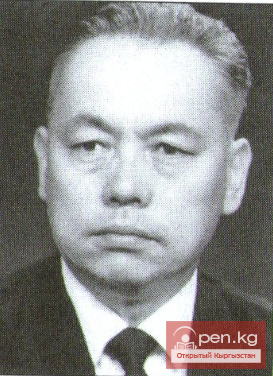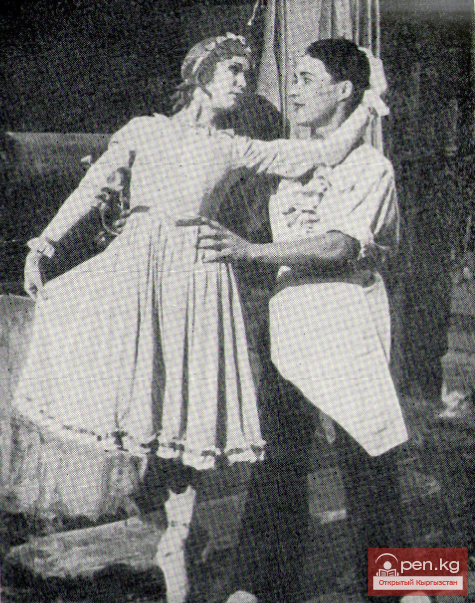
The Ballet 'Anar'
The ballet 'Anar' marked a new page in the history of Kyrgyz theatrical art. The theater already had musical dramas, a national opera, and classical ballet in its repertoire. All of this led to the birth of a new form of theatrical art, which is national ballet.
On the anniversary of October, November 7, 1940, the premiere of the ballet 'Anar' took place, created by composers V. Vlasov and V. Fere based on the libretto by K. Eshmambetov and N. S. Kholfin. The production was directed by V. V. Kozlov and N. S. Kholfin.
Since then, for more than 25 years, the performance 'Anar' has remained in the repertoire of the Kyrgyz Academic Theater of Opera and Ballet.
The basis of the libretto is a popular plot in Kyrgyz folklore about a poor girl who is captivated by a wealthy manap.
The action of the ballet begins early in the morning on the shore of a picturesque mountain lake. A young shepherd, Kadir, plays the choro. The melody carries both dreamy sadness and the joy of awakening feelings. Hearing Kadir's inviting song, Anar comes to the lake with her friends. They start playing and having fun. Left alone, Anar and Kadir reveal their feelings for each other. Again, a joyful melody sounds. It seems that all of nature rejoices in pure youthful love. But suddenly, it seems as if clouds cover the sky. The manap Bagysh appears with his horsemen. Struck by Anar's beauty, the manap does not feel the need to be shy with a simple girl. Kadir defends his beloved's honor and defeats the manap in a duel. Bagysh leaves, harboring hatred and a thirst for revenge.
The second scene transports the audience to the mountains. The youth gathers. Happy Anar and Kadir will announce their engagement today. People are having fun, dancing, and playing. Suddenly, the manap's horsemen appear. Anar is alarmed, sensing something bad. But the horsemen leave, and the festivities continue.
The third scene takes place in aail. A colorful yurt is visible, intended for Kadir and Anar. Their wedding is about to take place, and the people greet them, wishing them happiness. At this moment, a caravan stops in the aail. Kadir buys and gifts Anar a bright scarf, and she tenderly thanks her beloved. But joy quickly turns to sorrow. The manap's horsemen burst into the aail, and the wedding yurt is set on fire, Kadir is wounded, and Bagysh, seizing the unconscious Anar, disappears with her.
The last, fourth scene takes place in Bagysh's camp — high in the mountains, near a raging waterfall. Here, the manap brings his captive Anar. He tries to appease the girl with gifts, but she pushes away her hated captor. Soon, Kadir and the people appear. In his flight, Bagysh falls from a cliff into the raging waterfall and perishes. The people rejoice. The lovers are together again.
This is the plot outline of the performance. In the first production of 1940, it consisted of five scenes, not four as it is now. The subsequent reduction in the number of scenes did not significantly change the storyline. In the second edition (1950), there was a small new episode: during the confrontation, Bagysh kills Kadir's friend Sapara, and the people swear to take revenge on the manap. In the last, third edition, this episode was omitted.
It is noteworthy that the first Kyrgyz ballet was not created on an abstract fairy-tale theme. Its content reflects a reality typical under the dominance of patriarchal customs and the unlimited power of feudal lords. The social theme resonates strongly and vividly in the ballet. There is no idealization of the past here.
The accents of good and evil are drawn with a straightforwardness that knows no compromise. This made the performance militant and intensified its ideological resonance. Considering that just a few years before this, Kyrgyz theater had been attempted to be used by bourgeois nationalists for their purposes, staging a series of performances that glorified the past with all its wild customs and traditions, a performance like 'Anar' clearly demonstrated that Kyrgyz art was developing along the lines of realism. The fact that the first Kyrgyz ballet revealed this very specific trend was crucial for the subsequent development of Kyrgyz ballet art.
The plot of 'Anar' is filled with many everyday scenes and vivid ethnographic material. The expressive dance of the shepherds, the temperamental 'Tak-teke', the dance of 'Komuzchi', the depiction of horse racing ('baigy'), and the women's round dance — all these are picturesque images of folk life.
In the first edition of the ballet, the foundation consisted not of classical poses, but of movements associated with games and folk dances, which N. S. Kholfin studied during his work on the dances in 'Altyn-Kyz' and 'Ai-Churek'.
For example, during the scene depicting the struggle between Kadir and Bagysh, the performers A. Mamakeev and G. Avtandilov quite directly reproduced, with many details, a real folk struggle. Or another example: during the dance of the komuzchi, performers R. Muzafarov, O. Kurmanbekov, Sh. Gafarov, and P. Lozovoy tossed the komuz above their heads, using sweeping gestures, precisely mimicking the manner of playing the komuz.
As noted, a fairly large ballet group was organized in the young theater, which included many talented young men and women. They were destined to become the first artists of Kyrgyz ballet — it was they who had to perform all the roles in 'Anar'. Of course, since then, the cast of performers has been updated several times, but the significance of the pioneers of Kyrgyz ballet, who had to be both students mastering new forms and creators of national ballet art, cannot be diminished.













































